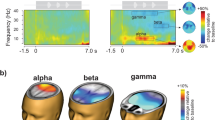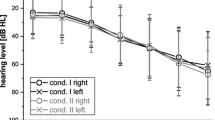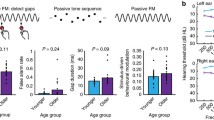Abstract
An increased listing effort represents a major problem in humans with hearing impairment. Neurodiagnostic methods for an objective listening effort estimation might support hearing instrument fitting procedures. However the cognitive neurodynamics of listening effort is far from being understood and its neural correlates have not been identified yet. In this paper we analyze the cognitive neurodynamics of listening effort by using methods of forward neurophysical modeling and time-scale electroencephalographic neurodiagnostics. In particular, we present a forward neurophysical model for auditory late responses (ALRs) as large-scale listening effort correlates. Here endogenously driven top–down projections related to listening effort are mapped to corticothalamic feedback pathways which were analyzed for the selective attention neurodynamics before. We show that this model represents well the time-scale phase stability analysis of experimental electroencephalographic data from auditory discrimination paradigms. It is concluded that the proposed neurophysical and neuropsychological framework is appropriate for the analysis of listening effort and might help to develop objective electroencephalographic methods for its estimation in future.







Similar content being viewed by others
References
Abry P (1997) Ondelettes et turbulence. Multirésolutions, algorithmes de décomposition, invariance d’échelles. Diderot Editeur, Paris
Bregman AS (1990) Auditory scene analysis. MIT Press, Cambridge
Bölcskei H, Hlawatsch F, Feichtinger HG (1998) Frame-theoretic analysis of oversampled filter banks. IEEE Trans Signal Process 46:3256–3268
Crick F (1984) Function of the thalamic reticular nucleus: The searchlight hypothesis. Proc Natl Acad Sci USA 81:4586–4590
Corona-Strauss FI, Bernarding C, Latzel M, Strauss DJ (2010) Auditory streaming and listening effort: an event related potential study (submitted)
Downs DW (1982) Effects of hearing aid use on speech discrimination and listening effort. J Speech Hear Disord 47:189–193
Dobie RA, Wilson MJ (1989) Analysis of auditory evoked potentials by magnitude-squared coherence. Ear Hear 10:2–13
Edwards E (2007) The future of hearing aid technology. Trends Amplif 11:31–45
Farge M (1992) Wavelet transforms and their applications to turbulence. Annu Rev Fluid Mech 24:395–457
Freeman WJ (1991) Induce rhythms of the brain. Birkhauser, Basel
Friston K (2005) A theory of cortical responses. Philos Trans R Soc Lond B Biol Sci 360:815–836
Grossberg S (1976) Adaptive pattern classification and universal recoding: I. Parallel development and coding in neural feature detectors. Biol Cybern 23:121–134
Grossberg S, Versace M (2008) Spikes, synchrony and attentive learning by laminar thalamocortical circuits. Brain Res 1218:278–312
Hicks CB, Tharpe AM (2002) Listening effort and fatigue in school-age children with and without hearing loss. J Speech Lang Hear Res 45:573–584
Hillyard SA, Hink RF, Schwent VL, Picton TW (1973) Electrical signs of selective attention in the human brain. Science 182:177–180
Husain FT, Tagamets MA, Fromm SJ, Braun AR, Horwitz B (2004) Relating neuronal dynamics for auditory object processing to neuroimaging activity: a computational modeling and an fMRI study. Neuroimage 21(4):1701–1720
Husain FT, Lozito TP, Ulloa A, Horwitz B (2005) Investigating the neural basis of the auditory continuity illusion. J Cogn Neurosci 17(8):1275–1292
Janata P (2001) Brain electrical activity evoked by mental formation of auditory expectations and images. Brain Topogr 13:169–193
Kahneman D (1973) Attention and effort. Prentice Hall, Englewood Cliffs
Kricos PB (2000) The the influence of nonaudiological variables on audiological rehabilitation outcomes. Ear Hear 21:7S–14S
Kotz SA, von Cramon DY, Friederici AD (2005) On the role of phonological short-term memory in sentence processing: Erp single case evidence on modality-specific effects. Cogn Neuropsychol 22:931–958
Kiessling J, Pichora-Fuller MK, Gatehouse S, Stephens D, Arlinger S, Chisolm T, Davis AC, Erber NP, Hickson L, Holmes A, Rosenhall U, von Wedel H (2003) Candidature for and delivery of audiological services: special needs of older people. Int J Audiol 42(suppl 2):2S92–2S101
Lachaux J-P, Rodriguez E, Martinerie J, Varela FJ (1999) Measuring the phase synchrony in brain signals. Hum Brain Mapp 8:194–208
Larsby B, Hällgren M, Lyxell B, Arlinger S (2005) Cognitive performance and perceived effort in speech processing tasks: effects of different noise backgrounds in normal-hearing and hearing-impaired subjects. Int J Audiol 44:131–143
Low YF, Corona-Strauss FI, Adam P, Strauss DJ (2007) Extraction of auditory attention correlates in single sweeps of cortical potentials by maximum entropy paradigms and its application. In: Proceedings of the 3rd international IEEE EMBS conference on neural engineering, Kohala Coast, pp 469–472
Mumford D (1992) On the computational architecture of the neocortex II. The role of the cortico-cortical loops. Biol Cybern 65:241–251
Misiti M, Misiti Y, Oppenheim G, Poggi J-M (2000) MATLAB-Wavelet toolbox, version 20. The Mathworks Inc., Natick
Näätänen R (1979) Early seelctive attention effects on the evoked potential: a critical review and reinterpretation. Biol Pychol 8:81–136
Näätänen R, Gaillard AWK, Mäntysalo S (1978) Early selective auditory attention effect on evoked responses reinterpreted. Acta Psychol 42:313–329
Oppenheim AV, Schafer RW (1989) Discrete-time signal processing. Prentice Hall, Englewood Cliffs
Polich J (2007) Updating P300: an integrative theory of P3a and P3b. Clin Neurophysiol 118:2128–2148
Pichora-Fuller MK, Singh G (2006) Effects of age on auditory and cognitive processing: implications for hearing aid fitting and audiologic rehabilitation. Trends Amplif 10:29–59
Raichle ME, Gusnard DA (2005) Intrinsic brain activity set the stage for expression of motivated behavior. J Comp Neurol 493:167–176
Rakerd B, Seitz PF, Whearty M (1996) Assessing the cognitive demands of speech listening for people with hearing losses. Ear Hear 17:97–106
Rennie CJ, Robinson PA, Wright JJ (2002) Unified neurophysiological model of eeg spectra and evoked potentials. Biol Cybern 86:457–471
Robinson PA, Rennie CJ, Rowe DL, O’Connor SC, Gordon E (2005) Multiscale brain modelling. Philos Trans R Soc Lond B 360:1043–1050
Robinson PA, Rennie CJ, Wright JJ (1997) Propagation and stability of waves of electrical activity in the cerebral cortex. Phys Rev E 56:826–840
Søndergaard PL (2007) Gabor frames by sampling and periodization. Adv Comput Math 27:355–373
Shinn-Cunningham BG, Best V (2008) Selective attention in normal and impaired hearing. Trends Amplif 12:283–299
Sauseng P, Klimesch W, Gruber WR, Hanslmayr S, Freunberger R, Doppelmayr M (2007) Are event-related potential components generated by phase resetting of brain oscillations? A critical discussion. Neuroscience 146:1435–1444
Strauss DJ, Delb W, D’Amelio R, Falkai P (2005) Neural synchronization stability in the tinnitus decompensation. In: Proceedings of the 2rd international IEEE EMBS conference on veural engineering, Arlington, pp 186–189
Strauss DJ, Delb W, D’Amelio R, Low YF, Falkai P (2008a) Objective quantification of the tinnitus decompensation by synchronization measures of auditory evoked single sweeps. IEEE Trans Neural Syst Rehabil Eng 16:74–81
Strauss DJ, Corona-Strauss FI, Froehlich M (2008b) Objective estimation of the listening effort: towards a neuropsychological and neurophysical model. In: Conference proceedings of the IEEE engineering in medicine and biology society, vol 1, pp 1777–1780
Strohmer S (1999) Rates of convergence for the approximation of dual shift-invariant systems in l2(z). J Appl Fourier Anal Appl 5:599–615
Suga N, Xiao Z, Ma X, Ji W (2002) Plasticity and corticofugal modulation for hearing in adult animals. Neuron 36:9–18
Trenado C, Haab L, Strauss DJ (2008) Multiscale modeling of auditory attention: forward modeling of large-scale neural correlates in evoked potentials. IEEE Trans Neural Syst Rehabil Eng 17:46–52
Trenado C, Haab L, Strauss DJ (2009) Corticothalamic feedback dynamics for neural correlates of auditory selective attention. IEEE Trans Neural Syst Rehabil Eng 17:46–52
Ullman S (1995) Links sequence seeking and counter streams: a computational model for bidirectional information flow in the visual cortex. Cereb Cortex 5:1–11
Varela F, Lachaux JP, Rodriguez E, Martinerie J (2001) The brainweb: phase synchronization and large-scale integration. Nat Rev Neurosci 2:229–239
Vidal J, Bonnet-Brilhaut F, Roux S, Bruneau N (2005) Auditory evoked potentials to tones and syllables in adults: evidence of specific influence on N250 wave. Neurosci Lett 378:145–149
Wesse GD, Phillips JM, Brown VJ (1999) Attentional orienting is impaired by unilateral lesions of the thalamic reticular nucleus in the rat. J Neurosci 19:10135–10139
Zikopoulos B, Barbas H (2006) Prefrontal projections to the thalamic reticular nucleus form a unique circuit for attentional mechanisms. J Neurosci 26:7348–7361
Zikopoulos B, Barbas H (2007) Circuits formultisensory integration and attentional modulation trough the prefrontal cortex and the thalamic reticular nucleus in primates. Rev Neurosci 18:417–438
Author information
Authors and Affiliations
Corresponding author
Appendix
Appendix
A1: Map of the gain parameters to the hearing path
The corticothalamic feedback dynamics in our model is represented by three different gains which we map to the hearing path in the following.
Gain G1: The auditory cortex projects indirectly to thalamic reticular nucleus (TRN) by means of axon-collaterals of corticothalamic projections. Additionally the TRN receives inhibitory input from dorsal thalamic nuclei. Thus, the TRN provides an inhibitory influence on the specific thalamus cores, namely the medial geniculate body (MGB) in the case of auditory evoked potentials. The target of TRN projections are the ventral and the medial subnuclei of MGB. The ventral subnucleus (VMGB) is specific for auditory processing, while the medial subnucleus (MMGB) receives also information from non-auditory pathways. The VMGB projects to anterior auditory field (AAF), the posterior auditory field (PAF) and the primary (A1) auditory cortex, the MMGB projects to the ipsilateral parts of the primary (A1), and the secondary (A2) auditory cortex, and to the ipsilateral posterior PAF and the anterior AAF auditory fields.
Gain G2: The auditory cortex projects directly to all the subnuclei of MGB, namely VMGB, MMGB, and the dorsal geniculate body (DMGB), which also gets informational input from earlier stages of the auditory pathway. Back projection to the cortex occurs as described above plus efferent projections from the dorsal subnucleus (DMGB) to the auditory cortex.
Gain G3: As described above the auditory cortex projects indirectly to the TRN by means of axon-collaterals of corticothalamic projections. The TRN has no efferent fibres projecting towards the auditory cortex, but is part of a thalamocortical feedback loop. The TRN receives additional input by axon-collaterals of thalamocortical projections. Due to its inhibitory influence on specific thalamus cores (i.e. MGB) the TRN can directly regulate information flow from thalamus to cortical areas.
A2: Wavelet and gabor frame phase synchronization
Wavelet Phase Synchronization Stability: We follow our definition of the WPSS as in Strauss et al. (2008a). Let \(L^2({\mathbb{R}})\) denote the Hilbert space of all square integrable functions, i.e., \(L^2({\mathbb{R}})=\{f : {\mathbb{R}} \mapsto {\mathbb{C}} : \int_{{\mathbb{R}}} |f(\mu)|^2 \hbox{d}mu < \infty\}.\) Let further ψa,b(·) = |a|−1/2ψ((· − b)/a) where \(\psi \in L^2({\mathbb{R}})\) is the wavelet with \(0< \int_{{\mathbb{R}}} |\Uppsi (\omega)|^2|\Uppsi(\omega)|^{-1} \hbox{d}\omega < \infty\; (\Uppsi (\omega)\) is the Fourier transform of the wavelet), and \(a,b\in {\mathbb{R}}, a\neq 0\). The wavelet transform
of a signal \(x \in L^2({\mathbb{R}})\) with respect to the wavelet ψ is given by the inner L2-product \( ({\mathcal{W}}_{\psi}x)(a,b)=\langle x,\psi_{a,b} \rangle_{L^2}.\) In the following, we restrict our interest to discrete time systems and signals such that all signals are represented by sequences. For the sake of a handy notation, we denote the index of the individual sequence elements as argument in square brackets. Let \(\ell^2\) denote the Hilbert space of all square summable sequences, i.e., \(\ell^2=\ell^2({\mathbb{Z}})=\{{\bf x} : {\mathbb{Z}} \mapsto {\mathbb{C}} : \sum_{m\in {\mathbb{Z}}} |x[m]|^2 < \infty\}.\) To compute the WPSS for such sequences in \(\ell^2\) rather than continuous time signals in \(L^2({\mathbb{R}})\), we used the discretization scheme of Misiti et al. (2000).
Tight Gabor Frames: We restrict our interest in the following further to time-invariant systems of the form \(\varphi_{m,n}[{\cdot}]=\varphi_{m}[{\cdot-}\alpha n], \quad n\in{\mathbb{Z}}, m=0,1,\ldots,M-1, \alpha\in {\mathbb{N}}_{> 0}\) where \(\varvec{\varphi}_{m}\in \ell^2.\) A set \(\{\varvec{\varphi}_{m,n} : m,n\in {\mathbb{Z}}, \varvec{\varphi}_{m,n} \in \ell^2\}\) is called a frame for \(\ell^2\) if
For A = B the frame is called a tight frame for \(\ell^2\) and we have the expansion \({\bf x} = A^{-1} \sum_{m,n\in {\mathbb{Z}}} \langle {\bf x}, \varvec{\varphi}_{m,n} \rangle_{\ell^2} \varvec{\varphi}_{m,n}.\) If \(||\varvec{\varphi}_m||_{\ell^2}^2=1 \forall m\in {\mathbb{Z}}\) and A = 1 we obtain orthonormal expansions and for A > 1 the expansion becomes overcomplete and A reflects its redundancy. Two frames \(\{\varvec{\varphi}_{m,n} : m,n\in {\mathbb{Z}}\}\) and \(\{\tilde{\varvec{\varphi}}_{m,n} : m,n\in {\mathbb{Z}}\}\) for the Hilbert space \(\ell^2\) are called dual frames if \({\bf x}=\sum_{m,n\in {\mathbb{Z}}} \langle {\bf x}, \varvec{\varphi}_{m,n} \rangle \tilde{\varvec{\varphi}}_{m,n}, \forall {\bf x} \in \ell^2.\) A Gabor system \((\varvec{\varphi},\alpha,M^{-1})\) for \(\ell^2\) is defined as
i.e, the system represents a family of sequences which are generated by one particular sequence due to modulation and translation. A Gabor system that is also a frame for \(\ell^2\) is called a Gabor Frame for \(\ell^2.\) For αM −1 > 1 the system is undersampled and cannot be a basis or a frame for \(\ell^2.\) For αM −1 = 1 we have the critically sampled case and, if the Gabor system represents a frame, it is also a basis. For α M −1 < 1 we have the oversampled case and the Gabor system cannot be a basis but a frame.
Tight Gabor frames have been constructed in Søndergaard (2007), Strohmer (1999). For a tight Gabor frame \(\{\varvec{\varphi}_{m,n} : m,n\in {\mathbb{Z}},\ \varvec{\varphi}_{m,n} \in \ell^2\}\) and an index set \({\mathcal{I}}=\{0,1,\ldots,M-1\}\) , we define the analysis operator by
We define synthesis operator with respect to the tight Gabor frame by
The described Gabor decompositions can also efficiently be implemented by oversampled uniform band discrete Fourier transform filter banks as shown in Bölcskei et al. (1998).
A3: Mathematical model of corticothalamic feedback
What follows is based on the large-scale evoked potential theory proposed in Robinson et al. (1997, 2005) and Rennie et al. (2002) adapted to our discussion in sections “A probabilistic auditory scene analysis framework” and “Corticofugal modulation and auditory late responses”.
According to Freeman (1991), within a neuron the relationship between the rate of incoming pulses from excitatory or inhibitory neurons Q ae or Q ai and their corresponding soma potentials V e or V i , can be obtained by an impulse response equation of the form,
where w(u) is a causal weight function with a characteristic width that satisfies
As stated in Robinson et al. (1997), a suitable choice for w(u) is given by
for u > 0, where α and β represent the rise and decay times of the cell-body potential produced by an impulse at a dendritic synapse. By combining Eqs. 7 and 8 for the case β ≠ α, the mean field soma potential V a (a = e, i excitatory and inhibitory), representing the synaptic inputs from various types of afferent neurons that are summed after being filtered and smeared out in time as a result of receptor dynamics and passage trough the dendritic tree, is governed by the following equation
where
N ab is the average number of synapses from neurons of type b = e, i, s on neurons of type a = e, i, where s stands for subcortical, S ab represents the magnitude of postsynaptic potentials, ϕ b represents fields of incoming pulses and τ ab are synaptic time delays.
In accordance to Rennie et al. (2002), the mean firing rate Q a related to cell-body potential V a is given by a sigmoidal-type function
where θ a is the mean firing threshold of neurons of type a, σ a is the standard deviation of this threshold in the neural population, and Q max is the maximum attainable firing rate.
An assumption that reflects the large-scale effect of neural populations is that each part of the corticothalamic system produces a field ϕ a of pulses, which travels at a velocity v a through axons with a characteristic range r a . Approximately such pulses propagate according to the damped-wave equation
where γ a = v a /r a . The simulation of auditory evoked cortical streams S is achieved by using a thalamic stimulus A n (k, w) of angular frequency w and wave vector k, which for convenience is chosen to be a unit Gaussian in time and space (centered at t 0s and r 0s with standard deviations t s and r s ), together with a function C l (k, w) which refers to an excitatory cortical activity of a short-range neural population with local connectivity, to define a corticothalamic transfer function
in which t d represents the time delay between thalamus and cortex, A represents an amplitude scaling factor, G1, G2, and G3 are the relevant corticofugal and intrathalamic gains, L z represents a dendritic transfer function that exerts a low pass filtering effect as given by
where \({\mathcal{N}}_{1}=\alpha,\eta_{1}\) and \({\mathcal{N}}_{2}=\beta,\eta_{2}\), and I xy stands for secundary gain factors. The indices for the parameters x, y, z = e, i, l, s, n, r denote e excitatory, i inhibitory, l excitatory cortical neurons with local axons, s excitatory thalamic neurons in specific and secondary relay nuclei, n excitatory afferents to thalamus, and r inhibitory thalamic reticular neurons. The response to the thalamic stimulus is given by
and the desired evoked potential streams can be obtained by using
here J 0 denotes the bessel function of first kind, and \({\mathcal{F}}^{-1}\) denotes the inverse Fourier transform, see Rennie et al. (2002) for more details.
Rights and permissions
About this article
Cite this article
Strauss, D.J., Corona-Strauss, F.I., Trenado, C. et al. Electrophysiological correlates of listening effort: neurodynamical modeling and measurement. Cogn Neurodyn 4, 119–131 (2010). https://doi.org/10.1007/s11571-010-9111-3
Received:
Revised:
Accepted:
Published:
Issue Date:
DOI: https://doi.org/10.1007/s11571-010-9111-3




